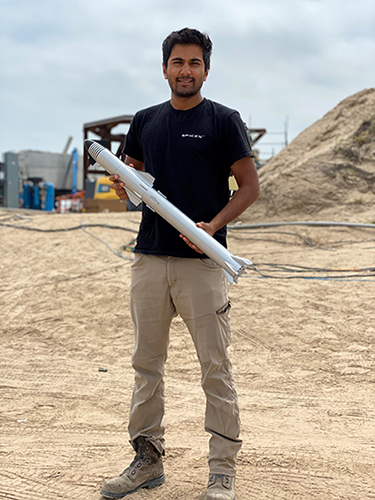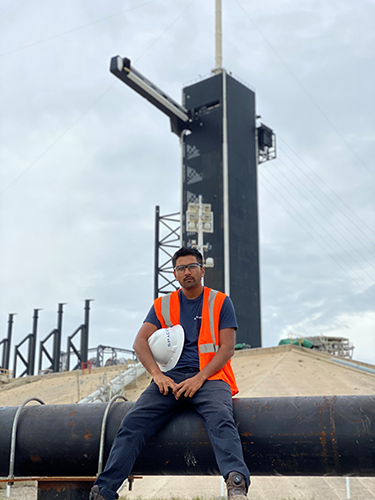Reaching for the Stars: Cal Poly Pomona Alumnus Helps SpaceX Starship Take Its Maiden Flight
 Rushi Patel’s first toy was a Lego Boeing airplane his father gave him when he was 10. Since then, he’s gone to countless air shows, watched more than 50 livestreamed rocket launches, and attended 10 live rocket launches. Now, he works as a Launch Engineer at SpaceX and takes flying lessons. He still has his Lego airplane, which reminds him of how far he’s gone.
Rushi Patel’s first toy was a Lego Boeing airplane his father gave him when he was 10. Since then, he’s gone to countless air shows, watched more than 50 livestreamed rocket launches, and attended 10 live rocket launches. Now, he works as a Launch Engineer at SpaceX and takes flying lessons. He still has his Lego airplane, which reminds him of how far he’s gone.
His main career goal is to become an astronaut.
“Rockets allow us to elevate ourselves physically and give us a new vantage point,” Patel (’19, aerospace engineering) said. “We don’t fully understand the sheer size of the universe, but to know that there is this one piece of technology that we’ve built that allows us to explore what’s out there is a beautiful feeling and it gives me tremendous hope for the future.”
Patel attended Cal Poly Pomona to be closer to his space dreams and idols in the United States – land of Neil Armstrong, NASA and the Apollo program. Patel was born in San Jose, California, but moved to India in the second grade. When he returned to California, he valued the diversity of thought and culture at Cal Poly Pomona, along with professors who worked hands-on in the aerospace industry.
He went to his first, live rocket launch in 2018, convincing his friends to drive him to Vandenberg Air Force Base, about three hours west of Pomona, in the wee hours of the morning before rush hour traffic. Patel was excited to see the launch of the InSight Mars Rover, designed to explore beneath Mars’ surface. At 4:05 a.m., Patel and his friends were startled awake by the roar of an Atlas V and heard the rocket fade away – they did not even see the fire streak through the sky because the fog was so thick.
“I still had so much pride in the fact that I heard a Mars Rover leave the planet,” Patel said. “It’s something that’s never going to come back to earth, and I was one of the last people who witnessed it in some shape or form.”
Patel watched the debut launch of SpaceX’s Falcon Heavy rocket in early 2018 from Room 1211 in Building 17 at Cal Poly Pomona, and said he was amazed that the two side boosters landed autonomously back on Earth. He was determined to watch a live launch of the rocket in 2019 and spent all his savings to go to the Kennedy Space Center in Florida. Weather-related delays pushed the launch back several days and Patel’s resources were depleted, forcing him to return to California. The rocket launched two hours after he landed back at Los Angeles International Airport and he watched another Falcon Heavy launch from a projector in Building 17. He took this experience, and with his parents’ support, flew out again to Florida to witness the third launch of the Falcon Heavy rocket.
 “Every rocket launch ingrains in my mind that this is really what my calling is,” Patel says. “The sheer magnitude of power, light and energy that’s being generated – it’s mesmerizing to see something like that lift off the ground and tear through the atmosphere.”
“Every rocket launch ingrains in my mind that this is really what my calling is,” Patel says. “The sheer magnitude of power, light and energy that’s being generated – it’s mesmerizing to see something like that lift off the ground and tear through the atmosphere.”
He was determined to work for SpaceX but was rejected 10 times from internships and employment positions. While Patel was giving a tour of the College of Engineering, a parent noticed his SpaceX shirt and asked if he worked there. When Patel said, “No. I wish I did,” the parent asked for his resume and a forwarded it to recruiters – the parent was a director at the SpaceX headquarters in Hawthorne, California.
“That interview was the most nervous I’ve ever been – I would borrow my professor’s office to attend phone interviews,” Patel said. “It was brutal. It was so technical, and I didn’t have any industry-worthy experience, but I had passion like no one else. I lived and breathed SpaceX.”
During his last semester at Cal Poly Pomona, he accepted an engineering position in a missile program in Arizona, but he gave one last shot at SpaceX. He emailed a recruiter and asked for any opportunity, even if it was a temporary position. He said he would walk away from a full-time job and possibly be blacklisted from the organization without any hesitation to work at SpaceX. They opened an associate engineering position in the Starship program at Launch Complex 39A at the Kennedy Space Center in Florida – the pad that launched Neil Armstrong to the moon - and he received his acceptance coincidentally on July 20, 2019, the 50th anniversary of the Apollo 11 lunar landing.
“Passion trumps talent,” Patel says. “If you can come to work so passionate about what you do, you’re going to learn fast and be of tremendous value to your team.”
Patel moved to Boca Chica, Texas to continue the development of the Starship rocket program, which features a fully reusable transportation system to carry crew and cargo traveling to Mars and beyond. He was part of a four-man team that worked on the world’s first solar powered launch pad and tested the first five Starship prototypes. In May of this year, Patel and his team conducted the first Starship static fire test. After multiple test failures, sleepless nights, 80 to 100-hour work weeks, Patel stood in the control room that night awaiting the static fire test.
“The clock hit T-10 seconds and all of a sudden the chaos faded away and all my heart could focus on was seeing that engine come to life - and then it did,” Patel says. “We made history that night - just like that.”
Just a few months later, the team went on to make history again when the fifth Starship prototype became the first Starship to successfully take flight on a 150-meter hop test. From dreaming about a career in space exploration as a kid to now having a launchpad with his name on it, he’s still reaching for higher until he reaches beyond the stars.
“I was a kid from Cal Poly Pomona with not a lot of experience, so looking back now, it is deeply humbling to be a part and at the forefront of such a revolutionary mission,” Patel says. “Find your passion. Find your purpose. And be relentless in your pursuit. Don’t settle.”